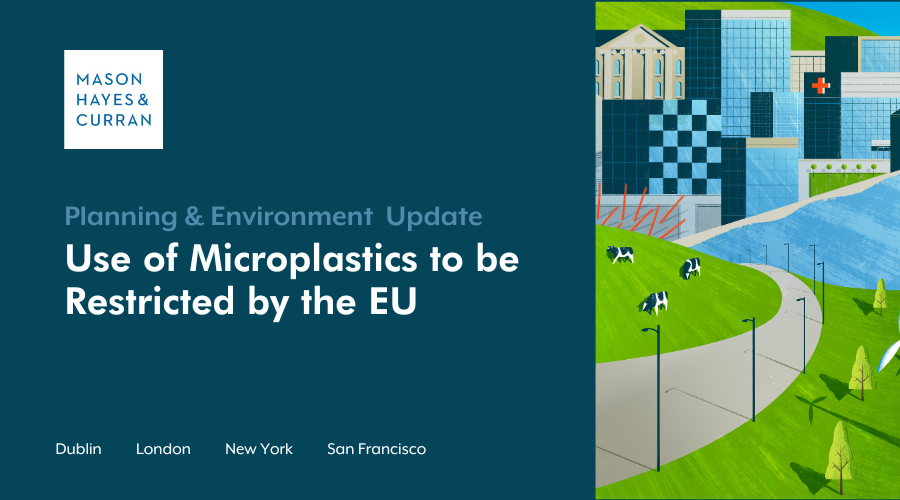Use of Microplastics to be Restricted by the EU

The EU’s amendment to the REACH Regulation is a significant step towards the reduction of plastic pollution in line with the European Green Deal, Circular Economy Action Plan and Zero Pollution Action Plan. Our Product Regulation & Consumer Protection team explains why these restrictions are likely to have a profound impact on the manufacturing and consumer industry.
The European Union recognises the environmental damage caused by the ubiquitous presence of synthetic or chemically modified natural polymers. These are insoluble in water, degrade very slowly and can be easily ingested by living organisms. Polymers, or ‘microplastics’, have been found in drinking water and food and accumulate to pollute the environment and be toxic.
Through a recent amendment to the Regulation on Registration, Evaluation, Authorisation and Restriction of Chemicals (REACH Regulation), the EU is taking action to restrict the intentional use of microplastics in consumer products. The amended law prohibits the placing on the EU market of microplastics, which are manufactured to be used on their own or as additives in products which release microplastics when used. These measures support the Zero Pollution Action Plan 2030 target to reduce microplastics released into the environment by 30%.
The amendment to the REACH Regulation entered into force on 17 October 2023. However, restrictions on certain products will take effect on a phased basis from between 2023 and 2035.
Scope
The EU has taken a broad interpretation of microplastics by including all synthetic polymer particles (SPMs) below five millimetres that are organic, insoluble and resist degradation.
Microplastics will be prohibited from being placed on the market except in limited circumstances. An exemption will apply to certain medicinal, agricultural and food products, and to products used at industrial sites or from which microplastics are not released during use. However, manufacturers will have to provide instructions on how to use and dispose of the product to prevent microplastic emissions.
Timeline for restrictions
The prohibition of microplastics in products will be introduced as follows:
- 17 October 2023 – SPMs that:
– Are solid, and
– Are contained in particles and constitute at least 1% by weight of those particles or build continuous surface coating on particles, and
– At least 1% of the particles referred to have dimensions equal to or less than 5mm or the length of particles is equal to or less than 15mm and their length to diameter ratio is greater than 3 - 17 October 2027 – Cosmetic products intended to be removed after application on the skin, hair or mucous membranes (rinse-off products)
- 17 October 2028 – Detergents, waxes, polishes, air care products, plant and mushroom fertiliser, and all other agricultural and horticultural products except for plant protection products
- 17 October 2029 – Medical devices, fragrances and cosmetic products intended to stay in prolonged contact with the skin, hair or mucous membrane (leave-on products)
- 17 October 2031 – Plant protection products, ie substances designed for the protection of crops, plants, etc, and granular infill for use on synthetic sports surfaces
- 17 October 2035 – Cosmetic products intended to be applied to lips, nails, and other make-up products
In addition, from 17 October 2025, suppliers of certain products containing SPMs will have to display information on the labels of these products. The information will need to include:
- Instructions for correct use and disposal
- Details and concentrations of SPMs in the product, and
- The applicability of the REACH Regulation to the product
From 2026, manufacturers and industrial downstream users of SPM pellets, flakes, and powders as feedstock in plastic manufacturing will be obliged to submit annual reports to the Environmental Protection Agency by 31 May each year. The reports will have to include details of the SPMs used in the previous calendar year, including an estimate of the amount of SPMs released into the environment as a result of their processes. This information will be made publicly available.
For the limited period of 17 October 2031 to 16 October 2035 inclusive, suppliers of cosmetic products intended to be applied to lips, nails and other make-up products will be obliged to ensure that these products have displayed on them the following statement: “This product contains microplastics.”
Conclusion
The EU’s amendment to the REACH Regulation is a significant step towards the reduction of plastic pollution in line with the European Green Deal, Circular Economy Action Plan and Zero Pollution Action Plan. Owing to the current widespread use of microplastics, these restrictions are likely to have a profound impact on the manufacturing and consumer industry.
Although the restrictions are to be introduced over a 12-year period, manufacturers and suppliers of products containing microplastics should become familiar with the restrictions now so that they have ample time to adjust their processes and plan for the future as necessary.
For more information, contact a member of our Planning & Environment team.
The content of this article is provided for information purposes only and does not constitute legal or other advice.
Share this:



